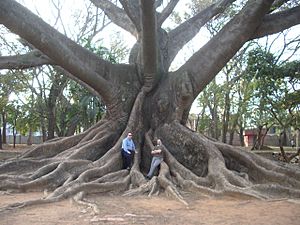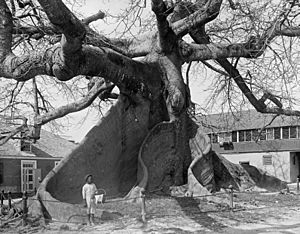The Great Kapok Tree facts for kids
The Great Kapok Tree is a popular American children's picture book. It teaches about protecting the rainforests. The book was written and illustrated by Lynne Cherry and first came out in 1990. It is dedicated to Chico Mendes, an environmental activist from Brazil who worked hard to save the rainforest.
What Happens in The Great Kapok Tree?
The story begins with two woodcutters in the Amazon rainforest. They stop next to a beautiful Ceiba tree, also known as a kapok tree. The bigger woodcutter points to the tree and then leaves. The other woodcutter feels sleepy because of the warm, buzzing forest. He falls asleep right under the Great Kapok Tree.
While he sleeps, many different animals that live in the tree come down to talk to him. These animals include frogs, snakes, sloths, birds, anteaters, and monkeys. They all explain how much they depend on the tree for their homes and food. They also tell him how important the tree is for the whole world.
The man wakes up and sees how beautiful the rainforest truly is. He picks up his ax, but the words of the animals echo in his mind. He faces a tough choice: should he follow the big man's orders, or listen to his own feelings? He thinks about everything the animals told him. Finally, he decides to leave the tree standing. He drops his ax and leaves the rainforest as a changed man.
How The Great Kapok Tree Was Created
In 1989, Lynne Cherry learned about the problems facing the Amazon rainforest. She believed that young people could help save it. She was studying at Yale University when she wrote The Great Kapok Tree. She wrote it during a train ride between New Haven and Washington D.C.
Soon after, Dr. Tom Lovejoy from the World Wildlife Fund (WWF) helped Cherry. He gave her a special artist residency at WWF. He and other scientists shared their rainforest photos for her to use as inspiration. Cherry also spent time in the "tropical forest" at the New York Botanical Garden.
With help from Dr. Lovejoy and other experts, Cherry traveled to Manaus, Brazil. This trip allowed her to experience the rainforest firsthand. She explored the huge forest around Lovejoy's research area. There, she sketched and photographed the amazing plants and animals.
When the book was released in 1990, it was around the twentieth anniversary of Earth Day. Lynne Cherry told a reporter that kids growing up would be the decision-makers in the future. She hoped that if they learned these ideas early, it would help shape national policies. She wanted to raise a whole generation of environmentalists.
Why the Kapok Tree is So Special
Lynne Cherry chose the Kapok tree (from the genus Ceiba) as a symbol for forest protection. This was a very fitting choice. Kapok trees are incredibly tall and wide. Some types can grow over 73 meters (240 feet) high and up to 5.8 meters (19 feet) across!
These impressive trees are important in many Native American stories. For example, in Maya mythology, kapok trees are seen as the Axis mundi. This means they connect heaven, earth, and the underworld. They are believed to support the entire universe. You can compare this to the mythical ash tree called Yggdrasil in Norse myths.
So, the kind woodcutter who decides to save one tree represents a bigger idea. It shows how humans can choose to stop destroying nature. This way, we can protect the natural world for all future generations.



